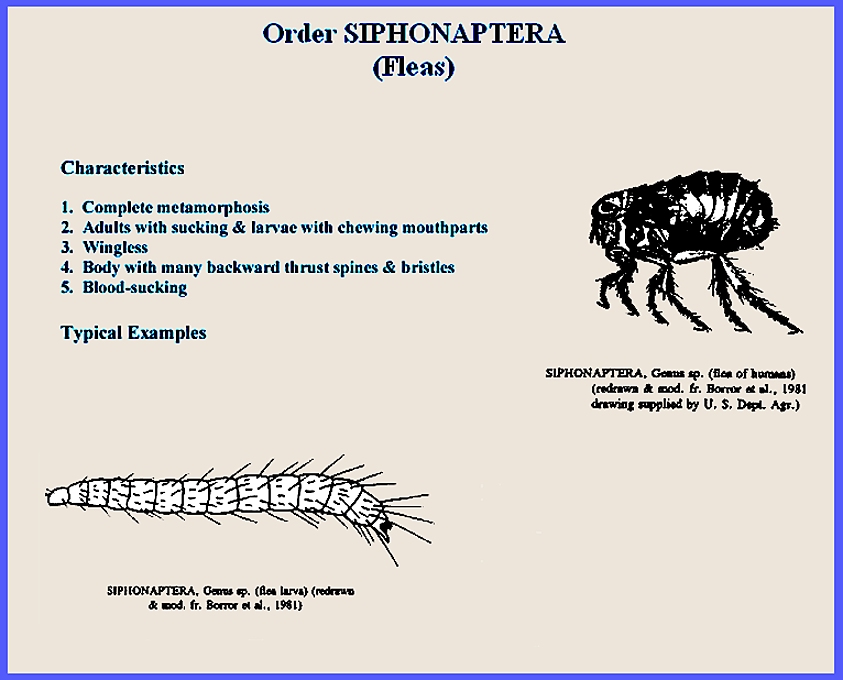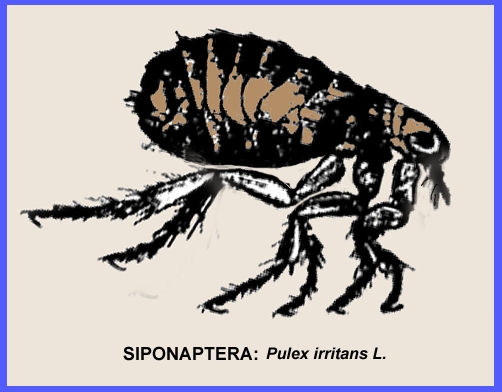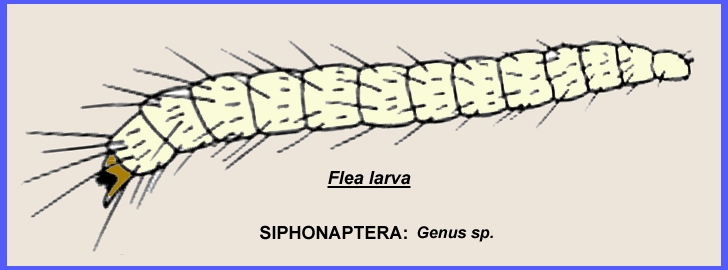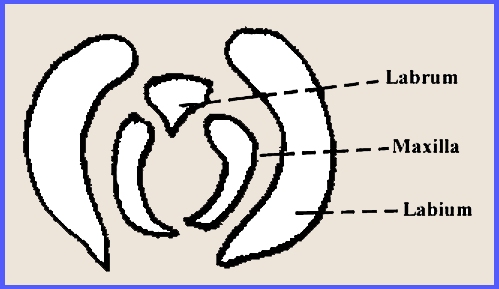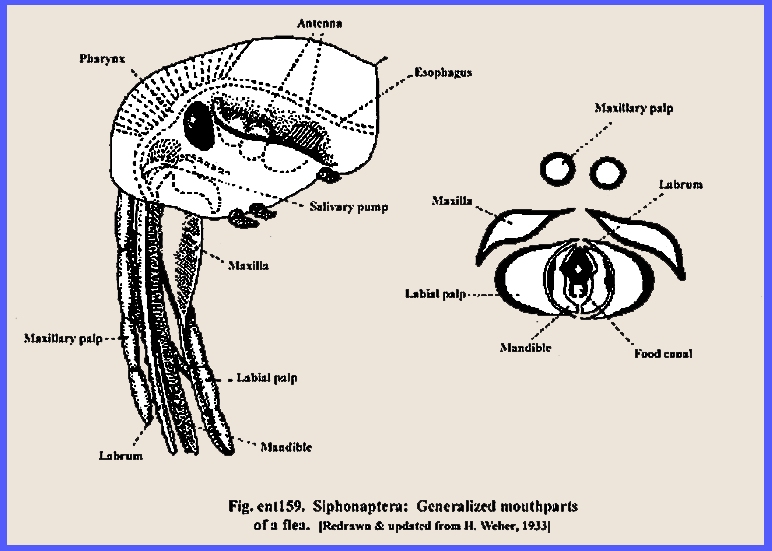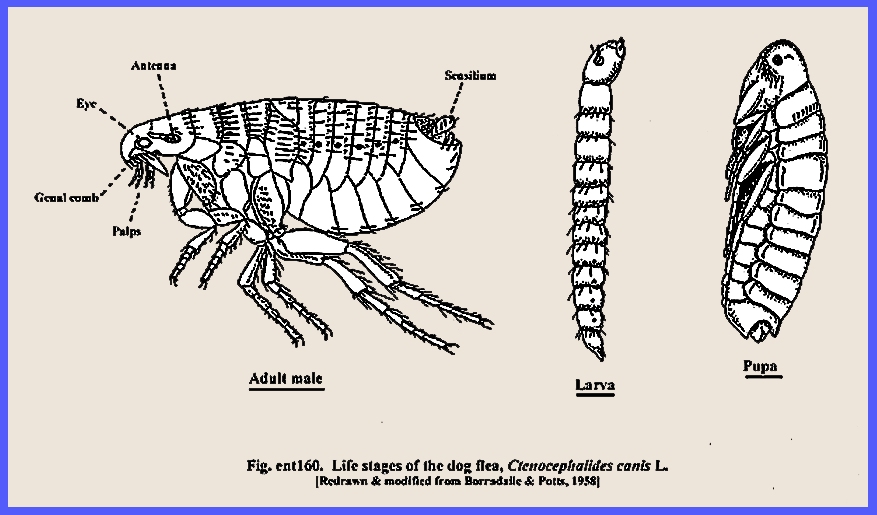File:
<siphonaptera.htm> (Entomology),
(Invertebrates), (General Index)> <Invertebrate Bibliography> <Glossary> <Site Description> < Home>
|
Entomology: SIPHONAPTERA 1 Kingdom: Animalia, Phylum: Arthropoda Subphylum: Hexapoda: Class: Insecta: Order: Siphonaptera (Contact)
Please CLICK on underlined
categories to view and on included illustrations to enlarge: Depress Ctrl/F to search for subject matter:
General Summary of
Siphonaptera Siphonaptera (or Suctoria)
are wingless insects that are ectoparasitic on warm-blooded animals. They are compressed laterally with short
antennae positioned in grooves. They
have piercing and sucking mouthparts, maxillary and labial palps are present,
coxae are large and the tarsus has five joints. Metamorphosis is holometabolous. The larvae are legless and the exarate pupae are enclosed in a
cocoon.
The mouthparts are made up of a
pair of long serrated mandibles, a pair of short triangular maxillae with
palps, and a reduced labium with palps. There is a short hypopharynx and a
larger labrum-epipharynx similar to that of the Diptera. The labial palps,
held together, serve to support the other parts, a function which is
performed by the labium in the Diptera. In piercing the host, the mandibles
are most important and blood is drawn up a channel formed by the two
mandibles and the labrum-epipharynx (Borradaile &
Potts, 1958). The thoracic segments are free and
wings are absent. Although the eggs are laid on the host they soon fall off
and are afterwards found in little-disturbed parts of the host's habitat. Therefore, in houses they reside in dusty
carpets and unswept corners of rooms.
In a few days the larvae hatch and feed on organic debris. The legless and eyeless larvae possess a
well-developed head and a 13-segmented body.
At the end of the third larval instar a cocoon is spun and the flea
changes into an exarate pupa from which the adult emerges. The whole life cycle takes about a month
in the case of Pulex irritans.. Pulex irritans is
the common flea of European houses, but by far the most important
economically is the oriental rat flea, Xenopsylla cheopis, which
transmits Bacillus pestis, the bacillus of plague, from the rat to
humans. This bacillus lives in the
gut of the flea and the faeces deposited on the skin of the host are rubbed
into the wound by the scratching which follows the irritation from the bite. Ceratophyllus
fasciatus, the European rat flea, also transmits the plague organism as
can also Pulex irritans, but since the latter does not live
successfully on rats, it is a less dangerous vector (Borradaile
& Potts, 1958). All members of
the Siphonaptera feed exclusively on warm-blooded animals. Their mouthparts lack mandibles and a
siphon is formed of structures of the labrum, labium and maxillae. The labium is an elongated and fleshy covering mechanism. The maxillae are interlocking and a
maxillary sheath is present but not obvious.
A labrum is also present. Fleas are apterous but their extinct ancestors are known to have possessed wings, which was
deduced from pleural plates on the thorax.
Hair-like structures called geocomb and corolla comb, are present on the head. The antennae have three segments and lie
in a groove on the head (see ent159). The larvae are eruciform with a
distinct head capsule. They do not
possess legs but leg-like setae instead.
Larvae are not parasitic.
There is an exarate pupa formed in a cocoon (see ent160). There are over 1,100 species
identified in the order. Their
general pest status of humans and domestic animals and their ability to
vector diseases makes them of great economic importance. Role as Parasites. --
Fleas are well adapted to the parasitic habit by being laterally
compressed. They also have a very
hard exoskeleton, their legs are developed for leaping and the hairs on their
body are directed backward. ----------------------------------------------- Diseases
Transmitted
by Siphonaptera Bubonic Plague. -- The
vector of Pasteurilla
pestis is the rat flea. This
bacillus wiped out one quarter of the population of London, England. The fleas search out other hosts as soon as
the rat dies. Transfer is
accomplished by (1) defecation on the body and the inoculum is scratched into
the wounds, and (2) the flea cannot digest the bacillus, so it regurgitates
into the wound made by its mouthparts. Sylvanic Plague. --
The vectors are fleas that live on rodent hosts. This is actually mild type of bubonic plague, which is found in
Western North America. However,
humans may also die from infection. Chigger Infection.
-- The fertilized female flea burrows under the skin and becomes enormously
distended. A serious tropical form is
known as Tunga
penetrans. Also
View "Medical Importance". ------------------------------------------- Details
of Insect Taxonomic Groups Examples of
beneficial species occur in almost every insect order, and considerable
information on morphology and habits has been assembled. Therefore, the principal groups of insect
parasitoids and predators provide details that refer to the entire class
Insecta. These details are available
at <taxnames.htm>. ============== |
